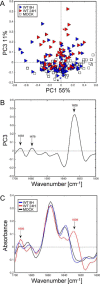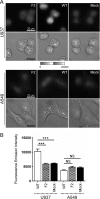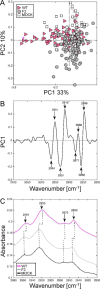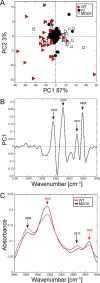Synchrotron Infrared and Deep UV Fluorescent Microspectroscopy Study of PB1-F2 β-Aggregated Structures in Influenza A Virus-infected Cells
- PMID: 26896002
- PMCID: PMC4861475
- DOI: 10.1074/jbc.M115.710533
Synchrotron Infrared and Deep UV Fluorescent Microspectroscopy Study of PB1-F2 β-Aggregated Structures in Influenza A Virus-infected Cells
Abstract
PB1-F2 is a virulence factor of influenza A virus (IAV) whose functions remain misunderstood. The different roles of PB1-F2 may be linked to its structural polymorphism and to its propensity to assemble into oligomers and amyloid fibers in the vicinity of the membrane of IAV-infected cells. Here, we monitored the impact of PB1-F2 on the biochemical composition and protein structures of human epithelial pulmonary cells (A549) and monocytic cells (U937) upon IAV infection using synchrotron Fourier-transform infrared (FTIR) and deep UV (DUV) microscopies at the single-cell level. Cells were infected with a wild-type IAV and its PB1-F2 knock-out mutant for analyses at different times post-infection. IR spectra were recorded in each condition and processed to evaluate the change in the component band of the spectra corresponding to the amide I (secondary structure) and the CH stretching region (membrane). The IR spectra analysis revealed that expression of PB1-F2 in U937 cells, but not in A549 cells, results in the presence of a specific β-aggregate signature. Furthermore, the lipid membrane composition of U937 cells expressing PB1-F2 was also altered in a cell type-dependent manner. Using DUV microscopy and taking advantage of the high content of tryptophan residues in the sequence of PB1-F2 (5/90 aa), we showed that the increase of the autofluorescent signal recorded in monocytic cells could be correlated with the IR detection of β-aggregates. Altogether, our results constitute an important step forward in the understanding of the cell type-dependent function of PB1-F2.
Keywords: Fourier transform IR (FTIR); amyloid; fluorescence imaging; influenza virus; membrane; microscopy; oligomerization; synchrotron radiation experiment.
© 2016 by The American Society for Biochemistry and Molecular Biology, Inc.
Figures









Similar articles
-
H5N1 Influenza A Virus PB1-F2 Relieves HAX-1-Mediated Restriction of Avian Virus Polymerase PA in Human Lung Cells.J Virol. 2018 May 14;92(11):e00425-18. doi: 10.1128/JVI.00425-18. Print 2018 Jun 1. J Virol. 2018. PMID: 29563290 Free PMC article.
-
PB1-F2 amyloid-like fibers correlate with proinflammatory signaling and respiratory distress in influenza-infected mice.J Biol Chem. 2021 Jul;297(1):100885. doi: 10.1016/j.jbc.2021.100885. Epub 2021 Jun 17. J Biol Chem. 2021. PMID: 34146545 Free PMC article.
-
Identification of cellular proteins interacting with influenza A virus PB1-F2 protein.Acta Virol. 2012;56(3):199-207. doi: 10.4149/av_2012_03_199. Acta Virol. 2012. PMID: 23043599
-
Current knowledge on PB1-F2 of influenza A viruses.Med Microbiol Immunol. 2011 May;200(2):69-75. doi: 10.1007/s00430-010-0176-8. Epub 2010 Oct 16. Med Microbiol Immunol. 2011. PMID: 20953627 Review.
-
Influenza A virus PB1-F2 protein: An ambivalent innate immune modulator and virulence factor.J Leukoc Biol. 2020 May;107(5):763-771. doi: 10.1002/JLB.4MR0320-206R. Epub 2020 Apr 23. J Leukoc Biol. 2020. PMID: 32323899 Review.
Cited by
-
Virulent PB1-F2 residues: effects on fitness of H1N1 influenza A virus in mice and changes during evolution of human influenza A viruses.Sci Rep. 2018 May 10;8(1):7474. doi: 10.1038/s41598-018-25707-y. Sci Rep. 2018. PMID: 29749408 Free PMC article.
-
Virus subtype-specific suppression of MAVS aggregation and activation by PB1-F2 protein of influenza A (H7N9) virus.PLoS Pathog. 2020 Jun 8;16(6):e1008611. doi: 10.1371/journal.ppat.1008611. eCollection 2020 Jun. PLoS Pathog. 2020. PMID: 32511263 Free PMC article.
-
Study of the host specificity of PB1-F2-associated virulence.Virulence. 2021 Dec;12(1):1647-1660. doi: 10.1080/21505594.2021.1933848. Virulence. 2021. PMID: 34125653 Free PMC article.
-
The Influenza Virus Protein PB1-F2 Increases Viral Pathogenesis through Neutrophil Recruitment and NK Cells Inhibition.PLoS One. 2016 Oct 31;11(10):e0165361. doi: 10.1371/journal.pone.0165361. eCollection 2016. PLoS One. 2016. PMID: 27798704 Free PMC article.
-
Nanoscopic Elucidation of Spontaneous Self-Assembly of Severe Acute Respiratory Syndrome Coronavirus 2 (SARS-CoV-2) Open Reading Frame 6 (ORF6) Protein.J Phys Chem Lett. 2023 Sep 28;14(38):8385-8396. doi: 10.1021/acs.jpclett.3c01440. Epub 2023 Sep 14. J Phys Chem Lett. 2023. PMID: 37707320 Free PMC article.
References
-
- World Health Organization (2014) Global Influenza Surveillance and Response System (GISRS), http://www.who.int/influenza/gisrs_laboratory/en
-
- Kawaoka Y. (ed) (2006) Influenza Virology: Current Topics, Caister Academic Press, Wymondham
-
- Zell R., Krumbholz A., Eitner A., Krieg R., Halbhuber K. J., and Wutzler P. (2007) Prevalence of PB1-F2 of influenza A viruses. J. Gen. Virol. 88, 536–546 - PubMed
Publication types
MeSH terms
Substances
LinkOut - more resources
Full Text Sources
Other Literature Sources
Medical
Miscellaneous

